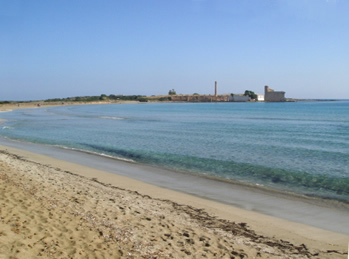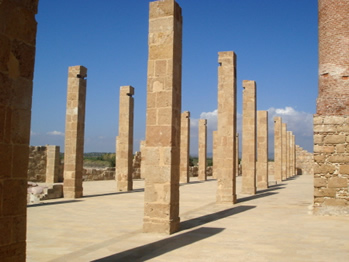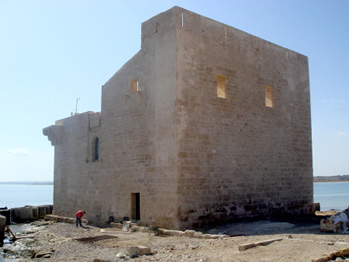TOURISM
IN SYRACUSE, SICILY
The
Nature Reserve of Vendicari
The nature
reserve of Vendicari, halfway between Syracuse
and Noto,
was founded in 1984 to protect one of the most important wetlands in Europe.
Hundreds of animal species inhabit it,
but particularly rich is the fauna of water birds, especially during migration
periods, when visiting the reserve becomes a must.
Among the species that inhabit or use
the Reserve during their migration are stilts, herons, storks, flamingos,
mallards, seagulls, cormorants, and others.
The area is
equipped with huts for bird-watching. The best period for this activity
is the month of December.
The Reserve also protects an area of Mediterranean
scrub in an excellent (and now rare, unfortunately) condition of conservation.
Visitors are required to observe some
simple rules of respect for nature, listed at the entrance.
 |
| One of the marshes
of the reserve, populated by flocks of waterfowl. |
The Former Salt Beds
Inside the Reserve are brackish marshes
that once were used as salt beds from which salt was extracted and used
to preserve fish in the nearby tuna plant (“tonnara”).
Part of this area of ponds is perennial,
while another - the largest - is drying up cyclically every summer.
The ponds are frequented by a great
population of waterfowl. The best time to observe them are the late
autumn and winter, when the marshes are flooded again after the period
of "dry" summer.
 |
| The beach and the
"Cala delle Mosche" of Vendicari. On the promontory, the Spanish Tower. |
The Beach
Within the reserve itself is a public
beach, particularly suited to those who have children with them; with the
caveat, of course, that the beach is not outfitted and is maintained in
its natural state: no booths (although one exists near the entrance), no
umbrellas... but also no motorboats.
In order to protect marine life, to the
right of the beach (that is, in the opposite direction of the tonnara and
the tower) swimming is not allowed, but one can swim on the left
side. As always, the greatest respect for nature is recommended and particularly
necessary in a natural park.
A curiosity: the sea throws onto the beach
strange
balls of filaments compacted by the motion of the waves and
produced by Posidonia
oceanica, a marine plant that in order to live needs absolutely
clear and unpolluted water: their presence therefore is not a form
of "pollution", but guarantees the cleanliness of the sea.
 |
| The pillars of the
tonnara’s shed. |
The Tonnara.
On the tip that demarcates the "Cala
delle Mosche" ("Cove of the Flies") rise the ruins of a
shed and of an industrial plant for the preparation of tuna, abandoned
after the war. A high chimney also stands on the complex.
The tonnara dates back to the 18th
century, although the atmospheric remains of the structure that one sees
(consolidated and rendered fit for use by a recent restoration) actually
date from 1920, when they tried a more distinctly “industrial” approach
(as evidenced by the chimney) to this traditional activity.
The activity itself is, however, more
ancient, going back to Greek times, as the archaeological
remains of facilities for the processing of fish (such as tanks dug
into the rock) can attest.
 |
| The "Svwabian Tower",
built by the Spanish in the first half of the 15th century. |
Tower (15th century)
Next to the tonnara you see the so-called
"Swabian
Tower", which actually dates
from the period of the Catalan
domination (it was built by Peter
of Aragon, 1416-1458), fresh from a restoration.
It was a military structure designed to
defend this area of the coast, and its economic activities, from attacks
from the sea.
When in use, it was equipped with a garrison
and two bronze cannons.
How to reach the nature reserve of Vendicari
from the Algilà
Ortigia Charme Hotel.
-
By Car.
-
To reach the reserve of Vendicari by car take
highway A18 Messina-Catania-Syracuse or highway A19 Palermo-Catania-Siracusa,
and exit at “Bivio Cassibile” and proceed to Strada Statale 115. From here
one needs to reach the provincial road Pachino-Noto and follow it for several
kilometers in the direction of “Torre Vendicari ", then follow the directions
to the reserve. At the entrance there is a large, secure car park (fees
apply).
-
By bus.
-
The Vendicari Reserve is connected to Syracuse
by the bus line "Interbus" (blue), telephone (++39) 0931 66 710.
-
By bicycle.
-
The journey can be made by using the bicycles
that the Hotel Algilà offers to its guests for free, bearing in
mind the fact that the distance between Syracuse and the reserve is approximately
40 kilometers / 25 miles.
Visitor Information
Admission to the reserve is free.
Schools and groups must book in advance
(telephone (++39) 0931 67450, fax (++39) 0931 62373).
For groups a free, guided tour (on alternate
days, from 9:00 a.m. to 1:00 p.m.) is available by reservation, provided
that the group does not exceed 50 people.
The route (on the road or on a boardwalk)
is accessible even to people with mobility problems.
Those who do not wish to dedicate an entire
day to the reserve may combine it with a visit to the city of Noto
(which requires a half-day) and to the Roman Villa
of Tellàro.
Back
to TOURISM IN SYRACUSE, SICILY




